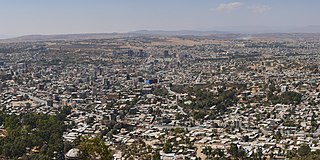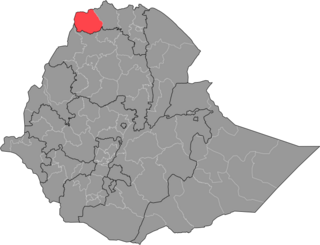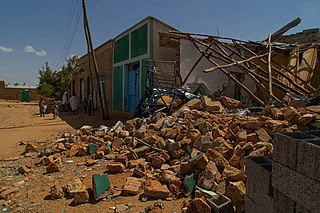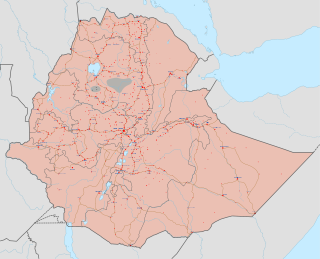
The Tigrai Region, officially the Tigrai National Regional State, is the northernmost regional state in Ethiopia. The Tigrai Region is the homeland of the Tigrayan (Tegaru), Irob people and Kunama people. Its capital and largest city is Mekelle. Tigrai is the fifth-largest by area, the fourth-most populous, and the fifth-most densely populated of the 11 regional states.

Mekelle, or Mekele, is a special zone and capital of the Tigray Region of Ethiopia. Mekelle was formerly the capital of Enderta awraja in Tigray. It is located around 780 kilometres (480 mi) north of the Ethiopian capital Addis Ababa, with an elevation of 2,254 metres (7,395 ft) above sea level. Administratively, Mekelle is considered a Special Zone, which is divided into seven sub-cities. It is the economic, cultural, and political hub of northern Ethiopia.

Shire, also known as Shire Inda Selassie, is a city and separate woreda in the Tigray Region of Ethiopia. The city is the administrative center of the Semien Mi'irabawi Zone. It was part of Tahtay Koraro district.

The Western Zone is a zone in the Tigray Region of Ethiopia. It is subdivided into three woredas (districts); from north to south they are Kafta Humera, Welkait and Tsegede. The largest town is Humera. The Western Zone is bordered on the east by the North Western Zone, the south by the Amhara Region, the west by Sudan and on the north by Eritrea. Starting from the late 17th C., internal boundaries are clearly shown, with 37 maps displaying a boundary that is located well south of the Tekeze River, or even south of the Simien mountains. Welkait is explicitly included within a larger Tigray confederation ; it is briefly mapped as part of Amhara in 1891-1894 and part of Gondar from 1944-1990. At other periods it appears independent or part of a larger Mezaga lowland region.

Welkait is a woreda in Western Zone, Tigray Region. This woreda is bordered to the north by Humera and to the south by Tsegede. It is bordered on the east by the North West Zone; the woredas of Tahtay Adiyabo and Asgede Tsimbla lie to the north-east, on the other side of the Tekezé River, and Tselemti to the east. The administrative center of Welkait is Addi Remets; other towns in the woreda include Mai'gaba and Awura.

Kafta Humera is a woreda in Tigray Region, Ethiopia. Located in the Western Tigray of Tigray, Kafta Humera is bordered on the south by Tsegede, on the west by Sudan, by the Tekezé River which separates Kafta Humera from Eritrea on the north, on the east by the North Western zone, and on the southeast by Welkait. Towns in Kafta Humera include Adi Hirdi and Humera.
Sheraro is a town and separate woreda in Tigray, Ethiopia. It is located in the North Western Zone of the Tigray Region, at an elevation of 1246 meters above sea level. It is the administrative center of Tahtay Adiyabo. It is near the border with Eritrea.

The Tigray War was an armed conflict that lasted from 3 November 2020 to 3 November 2022. The war was primarily fought in the Tigray Region of Ethiopia between forces allied to the Ethiopian federal government and Eritrea on one side, and the Tigray People's Liberation Front (TPLF) on the other.

The Mai Kadra massacre was a massacre and ethnic cleansing carried out during the Tigray War on 9–10 November 2020 in the town of Mai Kadra in Welkait in northwestern Ethiopia, near the Sudanese border. Responsibility was attributed to a pro-TPLF youth group and forces loyal to the Tigray People's Liberation Front (TPLF) in the EHRC-OHCHR Tigray Investigation, preliminary investigations by Amnesty International, the Ethiopian Human Rights Commission (EHRC) and the Ethiopian Human Rights Council (EHRCO), and interviews conducted in Mai Kadra by Agence France-Presse. The Office of the United Nations High Commissioner for Human Rights (OHCHR) and EHRC reported that at least 5 Tigrayans were killed in Mai Kadra by Amhara militas such as Fano in retaliation. Tigrayan refugees in Sudan told multiple news outlets that Tigrayans in Mai Kadra were targeted by either Amhara militias, the Ethiopian National Defense Force (ENDF), or both.
This timeline of the Tigray War is part of a chronology of the military engagements of the Tigray War, a civil war that began in the Tigray Region of Ethiopia in early November 2020.

Fano is an ethno-nationalist Amhara youth militia and former protest movement. Fano first emerged in the 2010s and during the 2016-2018 state of emergency as a protest movement against the former Ethiopian People's Revolutionary Democratic Front (EPRDF) government. Although Fano is hailed for being instrumental in bringing about the fall of the EPRDF through both non-violent and violent struggles, their current status and organizational structure are unclear. The territorial integrity of the ethnic Amhara "homeland" has been a key issue for Fano. Protests led by Fano in 2017-2018 were often centered around the issue of Western Tigray and the ethnic Amhara who lived there. As the purported "protectors" of Amhara society, the Fano have engaged in violent conflicts throughout the state in the name of neutralizing perceived threats to the Amhara people and, by extension, Amhara nationalism. Fano has become aligned with –and, in many instances, absorbed — the Amhara Regional Special Forces. Fano militias are primarily involved in armed clashes with the Tigray People's Liberation Front (TPLF), the Oromo Liberation Army (OLA), and the Ethiopian National Defense Force (ENDF). They have also clashed with the Sudanese Armed Forces (SAF) at the border of Ethiopia and Sudan.
On 3–4 November 2020, forces loyal to the Tigray People's Liberation Front (TPLF) launched attacks on the Ethiopian National Defense Force (ENDF) Northern Command headquarters in Mekelle and bases in Adigrat, Agula, Dansha, and Sero in the Tigray Region, marking the beginning of the Tigray War. The Ethiopian federal government stated that these attacks justified the ENDF's military action against the TPLF, which, at the time the attacks occurred, held control over the Tigray Region. The TPLF described the action as "a pre-emptive strike."

Ethnic discrimination in Ethiopia during and since the Haile Selassie epoch has been described using terms including "racism", "ethnification", "ethnic identification, ethnic hatred, ethnicization", and "ethnic profiling". During the Haile Selassie period, Amhara elites perceived the southern minority languages as an obstacle to the development of an Ethiopian national identity. Ethnic discrimination occurred during the Haile Selassie and Mengistu Haile Mariam epochs against Hararis, Afars, Tigrayans, Eritreans, Somalis and Oromos. Ethnic federalism was implemented by Tigray People's Liberation Front (TPLF) leader Meles Zenawi and discrimination against Amharas, Ogaden, Oromos and other ethnic groups continued during TPLF rule. Liberalisation of the media after Abiy Ahmed became prime minister in 2018 led to strengthening of media diversity and strengthening of ethnically focussed hate speech. Ethnic profiling targeting Tigrayans occurred during the Tigray War that started in November 2020.

All sides of the Tigray War have been repeatedly accused of committing war crimes since it began in November 2020. In particular, the Ethiopian federal government, the State of Eritrea, the Tigray People's Liberation Front (TPLF) and Amhara regional forces have been the subject of numerous reports of both war crimes and crimes against humanity.
The Battle of Humera was fought between Ethiopia and allied forces against forces loyal to the Tigray People's Liberation Front (TPLF) in the city of Humera during the Tigray War. The battle took place from 9 to 11 November 2020, and is the first recorded time Eritrean troops saw action. It also led to the Humera massacre when Amhara and Ethiopian troops started beating and killing civilians. Many more civilians were killed and wounded because of the shelling during the battle. After it was controlled by the Eritrean, Ethiopian and Amhara started house in house search detained everyone they found, loot every house and put the people in concentration camps. Day by day the Amhara forces killed the residents they put in the concentration camps, and dumped the bodies over the bridge into Tekeze River.

Following the 2018 dissolution of the ethnic federalist, dominant party political coalition, the Ethiopian People's Revolutionary Democratic Front, there was an increase in tensions within the country, with newly resurgent regional and ethnically based factions carrying out armed attacks on military and civilians in multiple conflicts throughout Ethiopia.
The Humera massacre was an ethnic mass murder event carried out in November 2020 in the town of Humera in the Tigray Region of northwestern Ethiopia, next to the Sudanese border. The massacre took place during an armed conflict between the regional government of Tigray and the federal government of Ethiopia. Refugees attributed the massacre to Amhara militias, including Fano, and the Ethiopian National Defense Force (ENDF).
This Timeline of the Tigray War is part of a chronology of the military engagements of the Tigray War, a civil war that began in the Tigray Region of Ethiopia in early November 2020.
This Timeline of the Tigray War is part of a chronology of the military engagements of the Tigray War, a civil war that began in the Tigray Region of Ethiopia in early November 2020.
The 1995 Ethiopian Federal Constitution formalizes an ethnic federalism law aimed at undermining long-standing ethnic imperial rule, reducing ethnic tensions, promoting regional autonomy, and upholding unqualified rights to self-determination and secession in a state with more than 80 different ethnic groups. But the constitution is divisive, both among Ethiopian nationalists who believe it undermines centralized authority and fuels interethnic conflict, and among ethnic federalists who fear that the development of its vague components could lead to authoritarian centralization or even the maintenance of minority ethnic hegemony. Parliamentary elections since 1995 have taken place every five years since enactment. All but one of these have resulted in government by members of the Ethiopian People's Revolutionary Democratic Front (EPRDF) political coalition, under three prime ministers. The EPRDF was under the effective control of the Tigray People's Liberation Front (TPLF), which represents a small ethnic minority. In 2019 the EPRDF, under Abiy, was dissolved and he inaugurated the pan-ethnic Prosperity Party which won the 2021 Ethiopian Election, returning him as prime minister. But both political entities were different kinds of responses to the ongoing tension between constitutional ethnic federalism and the Ethiopian state's authority. Over the same period, and all administrations, a range of major conflicts with ethnic roots have occurred or continued, and the press and availability of information have been controlled. There has also been dramatic economic growth and liberalization, which has itself been attributed to, and used to justify, authoritarian state policy.
















